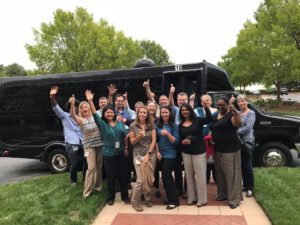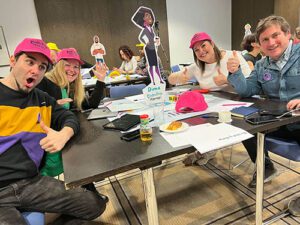Employee resource groups (ERGs) have grown more and more popular as workplace diversity and inclusion programs have become commonplace. These identity-based groups can help bring people together, foster a sense of community, increase engagement, boost creativity, and much more. This makes them indispensable in the modern workplace.
Today, let’s talk about ERGs—what they are, why they’re important, and how you can start one in your workplace.
What Are Employee Resource Groups?
Employee resource groups are employee-led, voluntary groups that focus on diversity, equity, inclusion, and belonging (DEIB) and bring employees of similar demographics and interests together. They form around a commonality, such as veterans, women in STEM, or LGBTQ+ employees.
These groups allow like-minded employees to connect, support each other, collaborate, and work out issues relevant to the group. A women’s group, for example, may help women build friendships, network, and deal with problems faced by women in the workplace.
Ultimately, ERGs are valuable resources that help bring workplaces together, support employees who may be more prone to exclusion, and create a positive and healthy workplace.
ERG Trends
With ERGs becoming more and more popular, there are certain trends emerging. Having knowledge of these trends can help you make your ERG(s) more effective. So let’s have a look at three key trends.
As ERGs become more and more common, they’ve started to become more organized. They now have their own forms of governance, strategies, missions, and goals. Organizations need to keep up with the trends and make sure their ERGs are well organized.
Ineffective ERGs can make employees feel excluded—in fact, 41% of employees in ineffective ERGs report still feeling excluded within their company. If employees can’t find inclusion and belonging in ERGs, it can make them isolated and disconnected from their workplace.
Support from management and clear communication are key. Running and operating an ERG can be a lot of work, so management support is essential. And clear communication makes everything go smoother, as with most things in business.

Types of ERGs
It’s important to note that there are numerous types of employee resource groups. Here is a list of some of the most common characteristics ERGs are formed around:
- Gender/sexual orientation.
- Religion.
- Age/parental status.
- Shared interests.
- Disabilities.
- Mental health.
- Nationality.
- Ethnicity.
- Socioeconomic status.
These are just some of the most popular ones, and ERGs can form around nearly any common characteristic or interest.
Why Are Employee Resource Groups Important?
We’ve talked a lot about the what but not much about the why. There are many benefits of employee resource groups, so let’s go through some of them one by one.
They Foster a Sense of Belonging
Employee resource groups can be a space for employees to connect, form bonds, and get support from those around them. This can prevent a toxic work environment, keep employees engaged, and benefit their mental health.
They Drive Innovation and Creativity
ERGs also serve as a place where employees can share different ideas and perspectives, resulting in bolstered innovation and creativity in the workplace. When employees feel a sense of psychological safety, they’re more likely to voice new ideas and get creative with work processes.
They Help Build Employee Confidence
Having a group to support you, discuss ideas, and provide a sense of belonging can increase an employee’s confidence—just like wellbeing initiatives. When employees are supported by their colleagues, they’re more likely to feel confident when speaking up, making decisions, and advocating for themselves.
They Increase Engagement and Retention
Lastly, by helping employees build confidence, belonging, and group synergy, ERGs can also help employees feel more engaged, boosting retention and overall job satisfaction.

How to Start an Employee Resource Group
With the what and why covered, now it’s time to talk about how. Starting an ERG can be difficult, so you need to know the steps and employee resource groups best practices. Here is our step-by-step guide on starting an ERG:
Assess and Plan
Gauge interest and need, define purpose and goals, and secure executive sponsorship. Find out who’s interested, what their needs are, what you want the ERG to accomplish, and get leadership on board to support the process.
Form the Core Team
The core team is made up of the employees who will take charge and run the ERG for the most part. You want to recruit passionate leaders—people who will go above and beyond to make the ERG a success. You also need to establish roles and responsibilities. An ERG is a lot of work, so dividing up the work and delegating responsibilities is absolutely essential to the success of an ERG. Ensure you’ve chosen a president, recruitment manager, and any other roles you deem necessary.
Develop Structure
With a core team in place, now you need to develop a structure. How will it be governed? How will new members be accepted? What guidelines will there be for activities and communications? These are all key questions you need to answer.
Secure Resources
After developing a structure, the next step is securing resources. Figure out the necessary budget and support needed, then work with HR to allocate those resources. This step is challenging for many, which is why getting support from management early on is essential. That makes this step much easier since they’re already on board with the endeavor.
Launch and Promote
Now that the planning and preparation is complete, it’s time to launch and promote. Host a kickoff event to get things started and implement a communication strategy to attract new members. An ERG needs to grow and show people why they should join, so you have to make an active effort to promote your group. It doesn’t have to be flashy or expensive, but you need to encourage people to join.
Execute and Evaluate
Lastly, begin planned activities and initiatives and start making the most of your newly formed ERG. Be watchful and make sure things are going smoothly and as planned. On top of that, you need to evaluate. Regularly assess progress and impact, make adjustments as needed, and report results to leadership. This is key to the long-term success of your ERG, as well as getting continued support from management.
Employee Resource Group Examples
Even with a clear guide, it can still be difficult to see exactly how an ERG functions and is successful. Here are some employee resource groups examples you can get inspiration from.
King Games
King Games, the creators of Candy Crush, noticed through surveys that many non-males felt excluded in their male-dominated workplace/industry. To deal with this, they created a non-male mentorship program called Kicking Glass. The end result of the program was an increase in gender diversity in hiring and promotions.
Women@Microsoft

Another successful ERG is Microsoft’s Women@Microsoft. This ERG focuses on decreasing the gender gap in tech and STEM by providing scholarships to women and nonbinary students. With this program, Microsoft has increased their percentage of women employees and made a noticeable impact on the gender gap in their industry.
Activities for Employee Resource Groups
Setting up an ERG can be a challenge, but so can finding activities for an ERG. Team building activities are a great way to help like-minded members bond. Here are some potential activities for your ERG:
Bond on the Go
Our Bonding Buses are a great option for ERGs. They help employees build bonds, work on creativity, teamwork, communication, and more—all of which can help an ERG grow and develop. We also have numerous options, such as a mystery bus, charity bus, and music bus. This gives you flexibility so you can choose the one that best suits your ERG and its needs.

Volunteer Together
Another good option for ERGs is charity activities. Your ERG can make an impact in your community, further your goals, and build bonds all at the same time. These activities are beneficial and fun, making them perfectly suited for ERGs.

Build Leadership Skills
Last but not least, Leadership Stories is another popular choice for ERGs. This event focuses on developing leadership skills, which can help the members of your ERG build confidence and communication skills.
This event also helps better teamwork as a whole since employees learn more about themselves and each other, helping them better understand and fit into their roles in the group.

Build and Strengthen Your ERGs with TeamBonding
Employee resource groups are becoming a more important part of business every year, and they aren’t going away. Businesses who want to be successful in the highly competitive modern marketplace need to utilize ERGs and take advantage of their benefits.
If you’re ready to reap the benefits of employee resource groups at your company, TeamBonding can help. Our events can help your ERGs grow closer together, build relationships, and gain valuable skills. Start the change you know is needed in your workplace by forming an ERG and getting in touch with us today!










